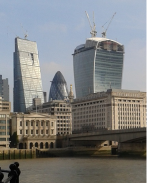[caption id="" align="alignright" width="300"] Queueing for the Proms 2008 on the south steps of the Royal Albert Hall (Photo credit: Wikipedia)[/caption]
I’m sitting on the steps outside the Royal Albert Hall in London. Fortunately today it isn’t raining, but even if it was, I needn’t worry. These days the Proms have an excellent system for managing the queue – rather like the ones on the deli counters in supermarkets. When you arrive, you are given a numbered ticket, which guarantees your place in the queue. Once you have your ticket, you can wander off for a coffee or a snack, or take shelter if it rains, knowing that everyone will be admitted in the order they joined the queue regardless. It is not particularly sophisticated – but it is a simple system, and it works.
Simplicity is hard-fought-for: it does not happen by accident. Once a complex process or system is in place, changing it to remove unnecessary complexity is hard, just as all change is. Even stopping a simple system getting more complicated needs constant vigilance: otherwise, it is likely to gather exceptions and special cases, as well as extra checks that seem important, but which have a cost which is frequently overlooked. Just as nature dictates that the disorder of the Universe (or a teenager’s bedroom) increases with time, and that this can only be reversed by the input of work, so it is with organisations.
Why does it matter? Because a simple system is inherently more efficient and less error-prone. Have you tried to explain your organisation’s processes to a new joiner? If so, how easy do you find it to explain the judgements required if the process has branches (if this, then that, but if not, then the other), and how quickly do people learn to make them properly? Good governance depends on people following the rules. Complexity makes it more likely that people will make mistakes, and also makes it harder to spot when people deliberately try to get round rules. For an extreme example of what happens with complexity, think about tax codes: with complex rules and many special cases, expert advisers earn a good living, which must be at the expense of either the tax-payer or the tax-collector or both. While that is good for the experts, does that not make its complexity bad for the rest of us?
Queueing for the Proms 2008 on the south steps of the Royal Albert Hall (Photo credit: Wikipedia)[/caption]
I’m sitting on the steps outside the Royal Albert Hall in London. Fortunately today it isn’t raining, but even if it was, I needn’t worry. These days the Proms have an excellent system for managing the queue – rather like the ones on the deli counters in supermarkets. When you arrive, you are given a numbered ticket, which guarantees your place in the queue. Once you have your ticket, you can wander off for a coffee or a snack, or take shelter if it rains, knowing that everyone will be admitted in the order they joined the queue regardless. It is not particularly sophisticated – but it is a simple system, and it works.
Simplicity is hard-fought-for: it does not happen by accident. Once a complex process or system is in place, changing it to remove unnecessary complexity is hard, just as all change is. Even stopping a simple system getting more complicated needs constant vigilance: otherwise, it is likely to gather exceptions and special cases, as well as extra checks that seem important, but which have a cost which is frequently overlooked. Just as nature dictates that the disorder of the Universe (or a teenager’s bedroom) increases with time, and that this can only be reversed by the input of work, so it is with organisations.
Why does it matter? Because a simple system is inherently more efficient and less error-prone. Have you tried to explain your organisation’s processes to a new joiner? If so, how easy do you find it to explain the judgements required if the process has branches (if this, then that, but if not, then the other), and how quickly do people learn to make them properly? Good governance depends on people following the rules. Complexity makes it more likely that people will make mistakes, and also makes it harder to spot when people deliberately try to get round rules. For an extreme example of what happens with complexity, think about tax codes: with complex rules and many special cases, expert advisers earn a good living, which must be at the expense of either the tax-payer or the tax-collector or both. While that is good for the experts, does that not make its complexity bad for the rest of us?
 Queueing for the Proms 2008 on the south steps of the Royal Albert Hall (Photo credit: Wikipedia)[/caption]
I’m sitting on the steps outside the Royal Albert Hall in London. Fortunately today it isn’t raining, but even if it was, I needn’t worry. These days the Proms have an excellent system for managing the queue – rather like the ones on the deli counters in supermarkets. When you arrive, you are given a numbered ticket, which guarantees your place in the queue. Once you have your ticket, you can wander off for a coffee or a snack, or take shelter if it rains, knowing that everyone will be admitted in the order they joined the queue regardless. It is not particularly sophisticated – but it is a simple system, and it works.
Simplicity is hard-fought-for: it does not happen by accident. Once a complex process or system is in place, changing it to remove unnecessary complexity is hard, just as all change is. Even stopping a simple system getting more complicated needs constant vigilance: otherwise, it is likely to gather exceptions and special cases, as well as extra checks that seem important, but which have a cost which is frequently overlooked. Just as nature dictates that the disorder of the Universe (or a teenager’s bedroom) increases with time, and that this can only be reversed by the input of work, so it is with organisations.
Why does it matter? Because a simple system is inherently more efficient and less error-prone. Have you tried to explain your organisation’s processes to a new joiner? If so, how easy do you find it to explain the judgements required if the process has branches (if this, then that, but if not, then the other), and how quickly do people learn to make them properly? Good governance depends on people following the rules. Complexity makes it more likely that people will make mistakes, and also makes it harder to spot when people deliberately try to get round rules. For an extreme example of what happens with complexity, think about tax codes: with complex rules and many special cases, expert advisers earn a good living, which must be at the expense of either the tax-payer or the tax-collector or both. While that is good for the experts, does that not make its complexity bad for the rest of us?
Queueing for the Proms 2008 on the south steps of the Royal Albert Hall (Photo credit: Wikipedia)[/caption]
I’m sitting on the steps outside the Royal Albert Hall in London. Fortunately today it isn’t raining, but even if it was, I needn’t worry. These days the Proms have an excellent system for managing the queue – rather like the ones on the deli counters in supermarkets. When you arrive, you are given a numbered ticket, which guarantees your place in the queue. Once you have your ticket, you can wander off for a coffee or a snack, or take shelter if it rains, knowing that everyone will be admitted in the order they joined the queue regardless. It is not particularly sophisticated – but it is a simple system, and it works.
Simplicity is hard-fought-for: it does not happen by accident. Once a complex process or system is in place, changing it to remove unnecessary complexity is hard, just as all change is. Even stopping a simple system getting more complicated needs constant vigilance: otherwise, it is likely to gather exceptions and special cases, as well as extra checks that seem important, but which have a cost which is frequently overlooked. Just as nature dictates that the disorder of the Universe (or a teenager’s bedroom) increases with time, and that this can only be reversed by the input of work, so it is with organisations.
Why does it matter? Because a simple system is inherently more efficient and less error-prone. Have you tried to explain your organisation’s processes to a new joiner? If so, how easy do you find it to explain the judgements required if the process has branches (if this, then that, but if not, then the other), and how quickly do people learn to make them properly? Good governance depends on people following the rules. Complexity makes it more likely that people will make mistakes, and also makes it harder to spot when people deliberately try to get round rules. For an extreme example of what happens with complexity, think about tax codes: with complex rules and many special cases, expert advisers earn a good living, which must be at the expense of either the tax-payer or the tax-collector or both. While that is good for the experts, does that not make its complexity bad for the rest of us?  A few years ago I needed to hire an assistant. I’d fixed an interview, and everything was organised. It was five minutes before the time the candidate was due, and I was just collecting my papers and my thoughts. At that moment, the din of the fire alarm started up.
There is – of course – nothing that you can do. Down the concrete back stairs, and out round the back of the building to the assembly point, into the London drizzle without a coat, while I imagined my interviewee arriving at the front. I had left all my papers on my desk in the dry, and had no other record of his contact details, so I had no way to suggest an alternative plan.
A little while later, my mobile rang. Having arrived and been barred from entry, he had managed to track down my mobile number himself, and we were able to arrange to carry on with the interview while we dried out in a local coffee shop. Needless to say, his resourcefulness impressed me and he got the job. Despite the unhelpful circumstances of the interview, he was one of my best hires ever.
Life has a habit of not going the way we plan it. Unexpected circumstances can often be turned to our advantage though, if we grasp them rather than trying to stick to the plan, and often the results are better than you could possibly have expected.
A few years ago I needed to hire an assistant. I’d fixed an interview, and everything was organised. It was five minutes before the time the candidate was due, and I was just collecting my papers and my thoughts. At that moment, the din of the fire alarm started up.
There is – of course – nothing that you can do. Down the concrete back stairs, and out round the back of the building to the assembly point, into the London drizzle without a coat, while I imagined my interviewee arriving at the front. I had left all my papers on my desk in the dry, and had no other record of his contact details, so I had no way to suggest an alternative plan.
A little while later, my mobile rang. Having arrived and been barred from entry, he had managed to track down my mobile number himself, and we were able to arrange to carry on with the interview while we dried out in a local coffee shop. Needless to say, his resourcefulness impressed me and he got the job. Despite the unhelpful circumstances of the interview, he was one of my best hires ever.
Life has a habit of not going the way we plan it. Unexpected circumstances can often be turned to our advantage though, if we grasp them rather than trying to stick to the plan, and often the results are better than you could possibly have expected.  “Many are stubborn in pursuit of the path they have chosen. Few in pursuit of the goal.”
Friedrich Nietzsche
Why does that matter? Because as circumstances change, the path has to change. Your objective, your destination, remains the same, but the path you need to take to get there has to take account of unforeseen obstacles, newly-visible short cuts, etc. Obstinately pursuing the original path may lead you into unnecessary difficulties or delays, or even to somewhere different altogether. Of course that assumes that you knew where you were going in the first place. In my experience, often people are unwilling or even unable to define their goals really clearly. If you don't do that, all you have left to cling to is the path you have chosen - even when it is leading you to the wrong place!
I’ve been told that, faced with an impending pile-up on the road in front of you, you are most likely to avoid it if you keep your eyes on the space you need to drive into, not on the car you are about to hit – but to do so is very hard! Similarly, being flexible enough to adapt the path you take through change, while keeping your eyes on the ultimate goal, is most likely to deliver what you wanted. Most of my work is concerned with 'soft' projects where the ability to flex when circumstances change is key. Nietsche captured the problem beautifully.
“Many are stubborn in pursuit of the path they have chosen. Few in pursuit of the goal.”
Friedrich Nietzsche
Why does that matter? Because as circumstances change, the path has to change. Your objective, your destination, remains the same, but the path you need to take to get there has to take account of unforeseen obstacles, newly-visible short cuts, etc. Obstinately pursuing the original path may lead you into unnecessary difficulties or delays, or even to somewhere different altogether. Of course that assumes that you knew where you were going in the first place. In my experience, often people are unwilling or even unable to define their goals really clearly. If you don't do that, all you have left to cling to is the path you have chosen - even when it is leading you to the wrong place!
I’ve been told that, faced with an impending pile-up on the road in front of you, you are most likely to avoid it if you keep your eyes on the space you need to drive into, not on the car you are about to hit – but to do so is very hard! Similarly, being flexible enough to adapt the path you take through change, while keeping your eyes on the ultimate goal, is most likely to deliver what you wanted. Most of my work is concerned with 'soft' projects where the ability to flex when circumstances change is key. Nietsche captured the problem beautifully.  The other night I was meeting a friend for dinner in town. You know how sometimes when you get down to the tube platform it feels wrong? It felt wrong. Too many people, milling about with resigned looks, not purposefully waiting. Then the public announcement: “the Victoria line is suspended from Victoria to Walthamstow Central. There is a shuttle service operating between Brixton and Victoria.”
No train. No boards telling you when the next train is coming either. I have a choice: I can take the chance of waiting, hoping that if a train does come soon I might still be on time – but it might be ages; or I can go out and catch a bus – I will definitely be a bit late, but I know it will definitely come?
The other night I was meeting a friend for dinner in town. You know how sometimes when you get down to the tube platform it feels wrong? It felt wrong. Too many people, milling about with resigned looks, not purposefully waiting. Then the public announcement: “the Victoria line is suspended from Victoria to Walthamstow Central. There is a shuttle service operating between Brixton and Victoria.”
No train. No boards telling you when the next train is coming either. I have a choice: I can take the chance of waiting, hoping that if a train does come soon I might still be on time – but it might be ages; or I can go out and catch a bus – I will definitely be a bit late, but I know it will definitely come?
How do we deal with risk?
It’s a nice example of how we human beings deal with risk. I don’t know about you, but my thought process goes something like this. First I will take the higher risk option – perhaps partly because it is where I am. As I wait, and nothing happens, I weigh up how late I am going to be if I catch the bus. At some point (if I am still waiting) I decide to cut my losses – either way I’m going to be late, so I opt for the more certain course and catch the bus. This time, I waited 10 minutes before changing to Plan B, and was 20 minutes late. If I had changed immediately I would only have been 10 minutes late. It’s not very rational – the sensible thing surely is to take the low risk option as early as possible, minimising the lateness, rather than just hoping that Plan A will avoid us being late at all, and then finishing up being later than we needed to be. But it seems to be human nature to take the optimistic view like this. Usually when we have to deal with risk there is some kind of pain threshold we have to exceed before we are willing to consider an alternative course, even though the sensible point to do so may have been much earlier. I don’t know how much unnecessary pain we suffer as a result, but I suspect it is significant! Do you need help identifying the change options you have to deal with risk? Please get in touch. A few years ago, I spent a fascinating week travelling around Europe. I was trying to put together a consortium to bid for funding from an EU industrial research programme. I was selling a vision. It was one of those “if its Wednesday I must be in France” trips, where after a couple of days my brain’s language processor gets so confused it just gives up attempting anything except English. Fortunately (but as usual), my hosts all put me to shame by speaking excellent English to me.
This trip taught me a very important lesson about selling a vision which I have used many times since. No organisation wants to be the first to commit to partnering when all they have is an outline description of the objectives of the partnership. They feel they need to know who else will be a part of it, and what the content of the programme will look like. Without this, they don’t even really want to share their ideas of what they might contribute or what benefits they might receive. On the other hand, until they do share their ideas it is impossible to put together a realistic programme. So where do you begin?
I describe what I did as “Castles in the air”. Think of the project as a fairy-tale castle floating above the ground. You have to be able to describe in some detail what this castle looks like from a distance. Of course, no-one can actually get to it to look inside, so much of the detail does not need to be filled in, but the description has to be convincing enough that everyone believes it is a real castle, not an illusion. In particular, they must never think that there is nothing holding it up!
A few years ago, I spent a fascinating week travelling around Europe. I was trying to put together a consortium to bid for funding from an EU industrial research programme. I was selling a vision. It was one of those “if its Wednesday I must be in France” trips, where after a couple of days my brain’s language processor gets so confused it just gives up attempting anything except English. Fortunately (but as usual), my hosts all put me to shame by speaking excellent English to me.
This trip taught me a very important lesson about selling a vision which I have used many times since. No organisation wants to be the first to commit to partnering when all they have is an outline description of the objectives of the partnership. They feel they need to know who else will be a part of it, and what the content of the programme will look like. Without this, they don’t even really want to share their ideas of what they might contribute or what benefits they might receive. On the other hand, until they do share their ideas it is impossible to put together a realistic programme. So where do you begin?
I describe what I did as “Castles in the air”. Think of the project as a fairy-tale castle floating above the ground. You have to be able to describe in some detail what this castle looks like from a distance. Of course, no-one can actually get to it to look inside, so much of the detail does not need to be filled in, but the description has to be convincing enough that everyone believes it is a real castle, not an illusion. In particular, they must never think that there is nothing holding it up!
Selling a vision
Putting that into project terms, there has to be a clear vision of what the project could do, broadly who may be involved and how they will benefit, even though none of it is agreed, and you have to feel and sound confident about it, just in order to get people talking about how they might contribute. Once you can get possible contributors to engage, they will help you fill in the detail, adapt the vision and underpin it with the foundations, until the whole project is solid enough to stand up by itself. The same principles apply to any situation where you need to influence many different people to win their support for the same idea. Unless you can describe your “castle in the air” with confidence, as though it were real and solid, it will be very difficult to get a hearing at all. The more people listen and contribute, even if they are not yet fully convinced, the easier it gets to win over others. Years ago, I was managing the sale of a business division. The business was based on carrying out a highly-specialised technical test on clients’ products, and each time a test was carried out, it made a loud bang. This would have been of no concern if it had not been that they were carried out in a large workshop also used for other activities. However, checks had been made and the noise levels were within legal safety limits.
Just before signing the deal, we happened to mention to the purchaser that we had some tests scheduled for the next day, and he said he’d like to send someone round to check the sound levels. It was a beautiful summer’s day – until their measurements showed that the bangs were over the limit. What a toe-curling moment! Clearly, we had made the wrong assumptions.
In the end it was not as bad as it seemed: a sound-attenuating box solved the problem without making access too difficult, at quite modest cost and with only a few weeks’ delay. But the proving tests provided another surprise – the noise levels were legal again without the box. The reason – we now realised – was that the humidity of the air could affect its sound-attenuating properties.
Years ago, I was managing the sale of a business division. The business was based on carrying out a highly-specialised technical test on clients’ products, and each time a test was carried out, it made a loud bang. This would have been of no concern if it had not been that they were carried out in a large workshop also used for other activities. However, checks had been made and the noise levels were within legal safety limits.
Just before signing the deal, we happened to mention to the purchaser that we had some tests scheduled for the next day, and he said he’d like to send someone round to check the sound levels. It was a beautiful summer’s day – until their measurements showed that the bangs were over the limit. What a toe-curling moment! Clearly, we had made the wrong assumptions.
In the end it was not as bad as it seemed: a sound-attenuating box solved the problem without making access too difficult, at quite modest cost and with only a few weeks’ delay. But the proving tests provided another surprise – the noise levels were legal again without the box. The reason – we now realised – was that the humidity of the air could affect its sound-attenuating properties.
Avoiding wrong assumptions
Conclusion 1 – Make sure you know what factors can affect your assumptions. Wrong assumptions may lead to disaster. Conclusion 2 – Don’t rely on conclusion 1! If something is critical, don’t rely on a modest safety margin – do what you can to increase it early, in case there is something you have not anticipated. Want to kill a good conversation dead instantly? Tell someone you are a physicist!
The editorial column in a professional magazine I sometimes read asked recently ‘what does “physics” mean to you?’ And it’s a good question – which I don’t propose to answer here! But it did set me thinking about what I mean when I say I am a physicist (yes, you guessed, I am), even though it is many years since I have done anything which would normally be called physics.
Want to kill a good conversation dead instantly? Tell someone you are a physicist!
The editorial column in a professional magazine I sometimes read asked recently ‘what does “physics” mean to you?’ And it’s a good question – which I don’t propose to answer here! But it did set me thinking about what I mean when I say I am a physicist (yes, you guessed, I am), even though it is many years since I have done anything which would normally be called physics.


